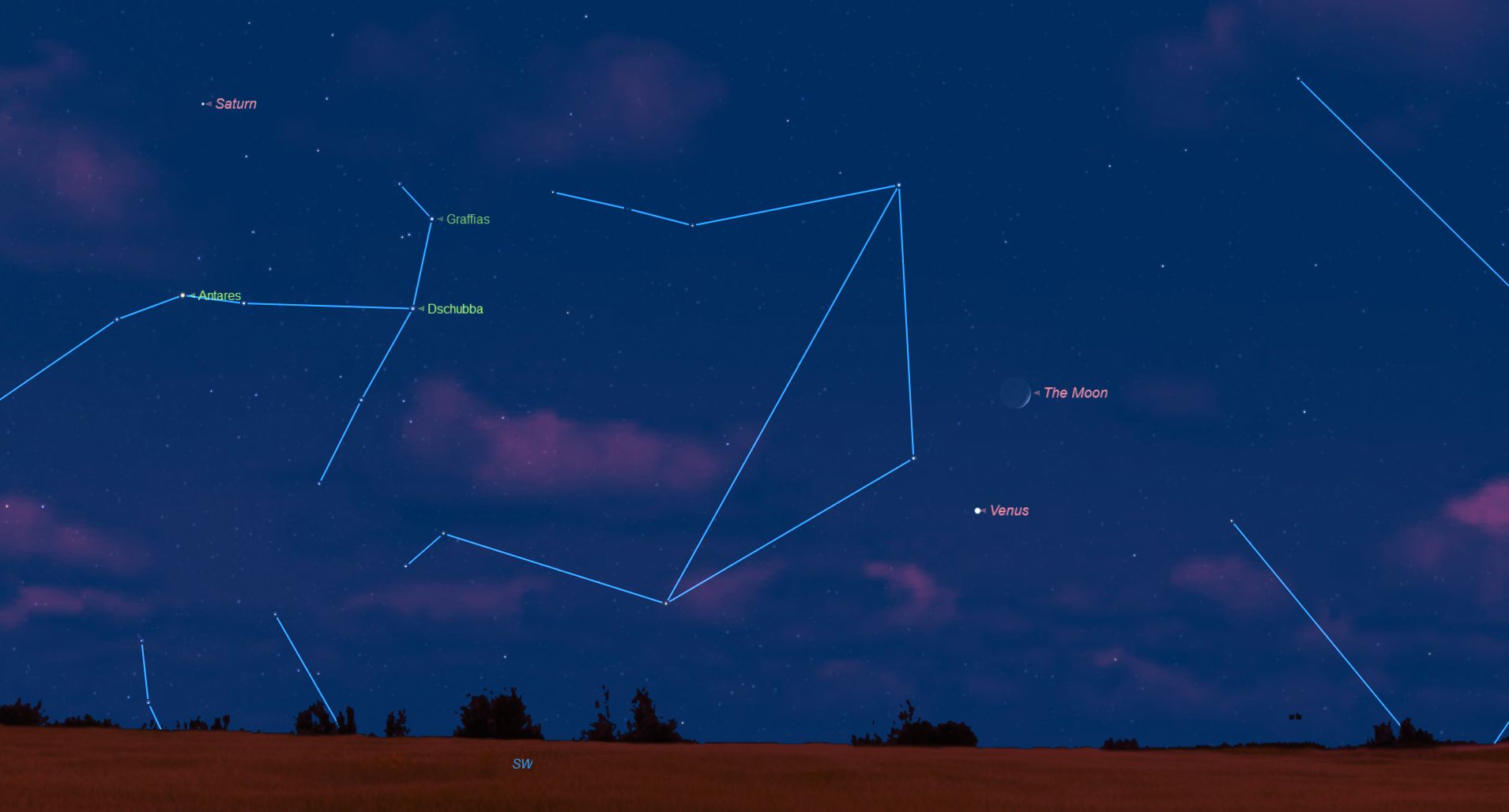A Venus-Moon Pairing to Delight Skygazers Tonight

This evening (Oct. 3) as darkness is falling, be sure to look low toward the west-southwest part of the sky for a beautiful celestial tableau: a lovely crescent moon and the brilliant planet Venus.
The moon will appear to hover about 5 degrees above and to the right of Venus. Your clenched fist held at arm's length measures about 10 degrees, so the moon and Venus will appear about "half a fist" apart.
These Venus-moon rendezvous occur on roughly a monthly schedule. In fact, if Venus were stationary and did not appear to move against the background of stars, then a Venus-moon encounter would occur every 27 days, 7 hours and 43 minutes. This is called a "sidereal month" — the length of time it takes the moon to circle the Earth once, using the background stars as a reference point. If we try to apply the sidereal-month rule to this schedule, then the next time Venus and the moon should appear to pair off would be Oct. 30. [Amazing Venus Photos by Europe's Venus Express Spacecraft]
If you go out and face west-southwest soon after sundown on that day, however, you'll see Venus — but the moon will be nowhere to be found. What happened?
Venus on the move
The calculations break down, of course, because Venus is not stationary, but is moving in its own orbit around the sun. In fact, the next time the moon will pass Venus will come on the evening of Nov. 2. From our earthly viewpoint, Venus will appear to move considerably to the east against the starry background. Tonight, Venus will be in the constellation of Libra, the Scales. But by next month — Nov. 2 — it will appear to have moved about 38 degrees to the east, where it will reside in the non-zodiacal constellation of Ophiuchus, the Serpent Holder.
So the moon has to travel that much more across the sky to catch up to Venus. Since the moon appears to move across the sky at about 13 degrees per day, it needs three more days (13 x 3 = 39) to catch up to Venus.
Indeed, on Nov. 2, we will once again be treated to the eye-catching sight of the night sky's two brightest objects in our western twilight.
Get the Space.com Newsletter
Breaking space news, the latest updates on rocket launches, skywatching events and more!
And we're moving, too!
We must also consider another factor: the Earth's movement around the sun. If, in fact, you do look for the crescent moon on Oct. 30 you won't see it because it will be at new phase and hence too near to the sun to be seen. That's because during the 27 days following Monday night's Venus-moon pairing, the Earth's movement around the sun will cause the sun's position in the sky to shift to the east as well.
And so in this case, come Nov. 2, the sun will appear to have shifted right into the very same region that Venus and the moon occupied on Oct. 3. Of course, by Nov. 2, the moon will have moved well clear of the sun and once again will be readily visible in the west-southwest along with Venus.
Lustrous evening star
Now gleaming at a very bright magnitude of minus 3.9, Venus in the coming weeks and months will ascend dramatically higher in the western sky and by New Year's Day it will be setting nearly 4 hours after the sun. And by February — incredibly — it will gleam twice as bright as now. No other star or planet can come close to matching Venus in brilliance, not even bright Jupiter, which currently is hidden in the glare of the sun. During World War II, aircraft spotters sometimes mistook Venus for an enemy airplane. There were even cases where Venus drew anti-aircraft fire.
And from Thanksgiving through Presidents' Day, it will dominate our evening sky.
Joe Rao serves as an instructor and guest lecturer at New York's Hayden Planetarium. He writes about astronomy for Natural History magazine, the Farmer's Almanac and other publications, and he is also an on-camera meteorologist for News 12 Westchester, New York. Follow us @Spacedotcom, Facebook and Google+. Original article on Space.com.
Join our Space Forums to keep talking space on the latest missions, night sky and more! And if you have a news tip, correction or comment, let us know at: community@space.com.

Joe Rao is Space.com's skywatching columnist, as well as a veteran meteorologist and eclipse chaser who also serves as an instructor and guest lecturer at New York's Hayden Planetarium. He writes about astronomy for Natural History magazine, Sky & Telescope and other publications. Joe is an 8-time Emmy-nominated meteorologist who served the Putnam Valley region of New York for over 21 years. You can find him on Twitter and YouTube tracking lunar and solar eclipses, meteor showers and more. To find out Joe's latest project, visit him on Twitter.









